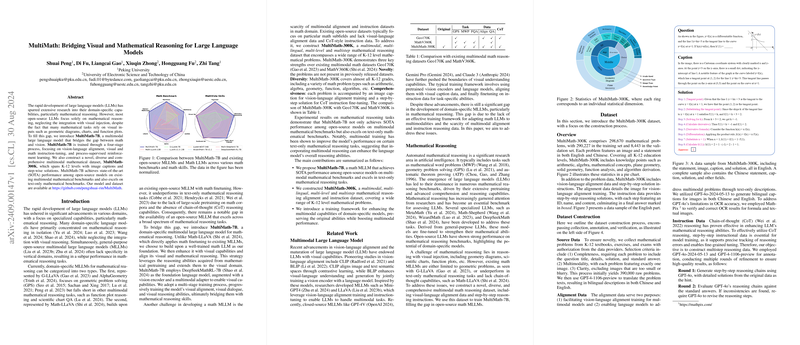The paper "MultiMath: Bridging Visual and Mathematical Reasoning for LLMs" introduces MultiMath-7B, a domain-specific multimodal LLM (MLLM) designed to integrate visual and mathematical reasoning. This model addresses a significant gap in current open-source MLLMs that typically lack comprehensive capabilities in handling combined visual and mathematical tasks, which are prevalent in many real-world applications.
Key Contributions
- Model Development: MultiMath-7B is a novel MLLM created to effectively handle multimodal mathematical reasoning tasks by integrating visual inputs into mathematical problem-solving. The model architecture builds on the strengths of vision-language alignment and endeavors to extend these capabilities to the mathematical domain.
- Training Methodology: The training process for MultiMath-7B is structured in four stages:
- Vision-Language Alignment: Aligns the vision encoder with the LLM to support visual input processing.
- Visual Instruction-tuning: Improves the model's ability to comprehend and respond to visual tasks.
- Mathematical Instruction-tuning: Enhances mathematical reasoning, targeting chain-of-thought (CoT) capabilities with rigorous multistep training.
- Process-Supervised Reinforcement Learning: Utilizes reinforcement learning to refine step-level reasoning processes, correcting errors through a preference-driven reward model.
- Dataset Construction: The MultiMath-300K dataset was developed to fuel the training of MultiMath-7B. This dataset is comprehensive, spanning a wide range of K-12 mathematical problems, and includes multimodal content with image captions for vision-language alignment, and detailed chain-of-thought solutions for training the model in stepwise mathematical reasoning.
- Benchmark Performance: MultiMath-7B demonstrates state-of-the-art performance among open-source models in multimodal mathematical reasoning tasks, outperforming several other models on datasets such as MathVista and MathVerse. It also surpassed existing models in more traditional text-only mathematical benchmarks.
Experimental Results
- Visual Math Benchmarks: MultiMath-7B excelled in tasks requiring both visual and mathematical reasoning, achieving higher accuracy in tasks involving geometry problem-solving and mathematical word problems compared to other models.
- Textual Math Benchmarks: The model maintained strong performance for text-based mathematical reasoning, providing competitive results against specialized mathematical models, particularly in problem-solving from foundational mathematics exams and competitions.
Discussion
The authors highlight the dual advantage of their approach:
- Reasoning Boost: The integration of multimodal training contributes significantly to the enhancement of reasoning capabilities, not only in the visual domain but also improving text-only reasoning tasks.
- Visual Enhancement: Injecting visual reasoning into the mathematical domain aids in forming a more robust problem-solving framework.
Conclusions
The paper concludes with an emphasis on the effectiveness of bridging visual and mathematical reasoning within a singular model framework. Future research directions include expansion to other domains and further fine-tuning techniques to increase the versatility and accuracy of such multimodal LLMs. The researchers provide a comprehensive comparative analysis, suggesting that the novel dataset and training methodologies have tangible impacts on the model's performance across a varied array of reasoning tasks.
